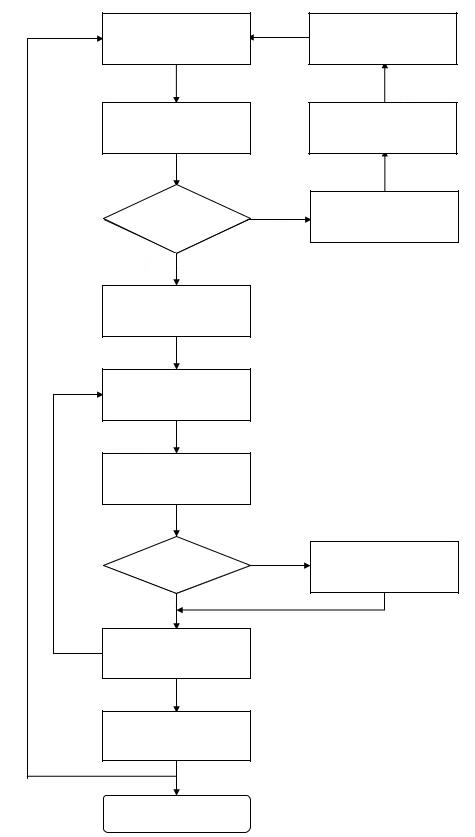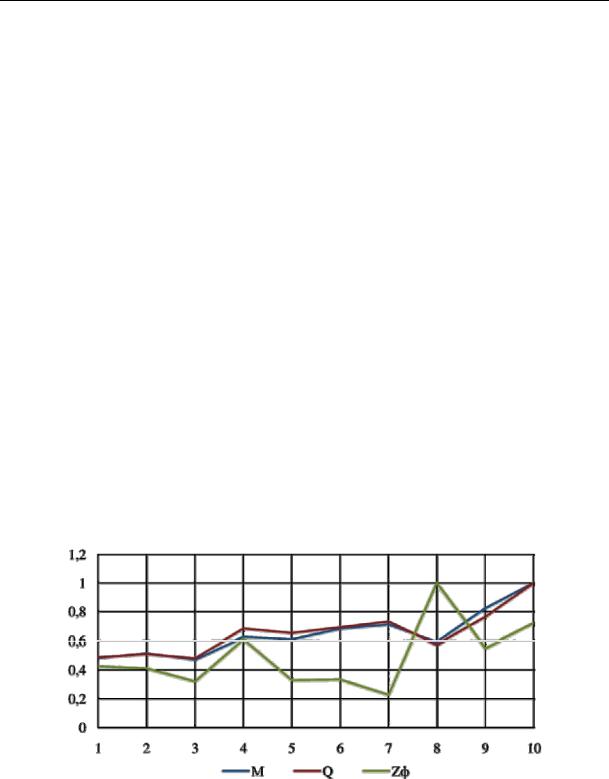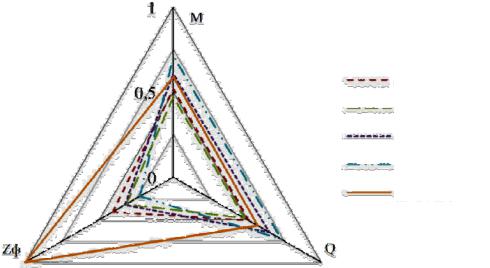
3395
.pdf
Russian Journal of Building Construction and Architecture
consumption [2, 4]. The development of new and improvement of existing software products for performing the functions of operational control, analysis of the process of measuring low gas consumption is one of the most important tasks for energy conservation and Russia’s economic development [10].
The software “Control of Energy Resources: CER 1-gas” was designed to quickly calculate the maximum permissible error of measurement by the gas meter in relative units (%) and in absolute value (m3/h) at the current set gas flow rate for various types of meters but did not take into account diameters of pipelines and pressure in the system as well as shapes of flow bodies around the sensitive element of the meter [14].
3. Purpose of the program. A new software “Control of Energy Resources: CER 2-gas” is designed to quickly calculate the maximum permissible error of measurement by the gas meter in relative units (%) and in absolute value (m3/h) for the current set gas flow rate, pipeline diameter, pressure for various types counters [15]. This makes it easier to check the functionality of the meters during periodic verification.
Unlike the software “Control of Energy Resources: CER 1-gas” designed to quickly calculate the maximum permissible error of measurement by the gas meter in relative units (%) and in absolute value (m3/h) at the current set gas flow rate for various types of meters, in the new software “Control of Energy Resources: KER 2-main”, in addition to consumption, the pipeline diameters and pressure are taken considered.
As an example of data, gas meters manufactured by ELSTER Gazelectronika LLC were selected: BK-G 1.6 ... 100 – 10 standard sizes with a nominal capacity of 0.016 to 160 m3/h (diaphragm-type meter).
By analogy, data on other types of meters, diameters, pressures are added to the program. The technical requirements for software and hardware for the software are as follows: MS Windows 98 and higher; Intel Pentium IV or higher; HDD 1 MB.
The procedure for working with the program looks like this:
1.Select the type of counter.
2.Select the meter model.
3.Set the required gas flow rate and press “Calculate”.
The graph will display the value of the permissible relative error at a given gas flow rate, pressure, diameter and its absolute limit value (in this case, 0.39 % and 0.02 m3/h, respectively). If an actual gas flow rate does not exceed these values, the gas meter at the specified flow rate works properly. It is required to check on other values of the costs.
The scheme of the software “Control of Energy Resources: CER 2-main” is shown in Fig.
30

Issue № 3 (47), 2020 |
ISSN 2542-0526 |
Input data interface
Calculate
Qx > Qmax
or Qx < Qmin
No
Calculating the relative consumption ‘z’
Calculating the relative error ‘h’
Graphic function representation
If X <= z
No
Cycle along the entire range X = 0 … 100 %
Calculation and output of the absolute specific error
End
Type, meter model Gas consumption, Qx, m3/h
Correcting function on the type
of a flowing body
Yes |
Qx = Qmax or Qx = Qmin |
|
Yes
Fixing the value ‘h’
Fig. Software “Control of Energy Resources: CER 2 – main”
31

Russian Journal of Building Construction and Architecture
The research results are the second stage of the work to substantiate the adopted hypothesis on the need to improve the accuracy of gas consumption metering in gas consumption networks, to prevent its uncontrolled leaks, to automate the flow control process and organize control actions in the event of hazardous situations associated with the involuntary accumulation of free gas suspensions in apartment and in-house premises.
The solution of the tasks was performed considering the accepted conditions of the constructive, technological, production and organizational plan.
As a result the following has been achieved:
––initial data have been collected and digitized by entering into the database a visualization model of low gas flow rates in gas-consuming systems in the format of special auxiliary software for process automation;
––based on the collected initial data, a simulation model of a vortex flow meter has been developed to account for low gas flow rates;
––a mathematical model has been designed for the operational control of the functioning of the gas supply system for in-house and in-house gas consumption based on the complex accounting of the parameter of the relative error of devices and equipment of the utility network;
––the software “Control of Energy Resources: CER 2-gas" (certificate of state registration No. 2019667428) has been developed which automates the calculation of the maximum permissible error of measurement by the gas meter in relative units (%) and in absolute value (m3/h) at the current specified gas flow rate, pipeline diameter, pressure for different types of meters;
––statistical data on the study of the functioning of gas distribution systems have been presented.
The results obtained are intended for use in accounting for low energy consumption.
The study involves the adaptation of the basic methods for assessing the reliability, risks and safety of systems in the theory of gas supply and regulation of gas flow metering. Conclusions. A computer software and an operation algorithm “Energy Resources Control: CER 2-main” have been developed which automate the calculation of the maximum permissible measurement error by the gas meter in relative units (%) and in absolute value (m3/h) according to the current specified gas flow rate for various types of meters, diameters, pressures. The results obtained are intended for use in the modernization of gas consumption systems to account for low energy consumption.
The study involves the adaptation of the algorithm and software with the preparation of recommendations for use in structural and design organizations engaged in developing new measuring equipment or assessing energy consumption in the framework of energy audits.
32
Issue № 3 (47), 2020 |
ISSN 2542-0526 |
The work has been performed within the framework of the project to obtain primary scientific results that ensure the expansion of the participation of subordinate educational organizations in the implementation of the National Technological Initiative No. 13.11847.2018 / 11.12 “Development of a Model for operational management of urban gas supply systems based on the principle of disturbance regulation" with the support of the NRU" Moscow State construction university”.
In follow-up studies, it is planned to bring the design model of the vortex flow meter to a prototype with variable models of built-in jet-swirling nozzles with a series of experiments; to design of a strain gauge sensitive element of a flow meter with an adaptively built-in software module for metering gas consumption as a dense medium with inclusions of various biotechnical impurities; to adapt the algorithm and software with the development of recommendations for use in structural and design organizations involved in developing new measuring equipment or assessing energy consumption as part of energy audits.
References
1.Vul'man V. A., Khor'kov N. S. Teplovye raschety na EVM teploenergeticheskikh ustanovok [Thermal calculations on the computer of thermal power plants]. Moscow, Energiya Publ., 1975. 199 p.
2.Gnezdilova O. A. Razrabotka modeli operativnogo upravleniya gorodskimi sistemami gazosnabzheniya na osnove printsipa regulirovaniya po vozmushcheniyu. Avtoref. diss. kand. tekhn. nauk [Development of a model for operational management of urban gas supply systems based on the principle of disturbance control. Cand. eng. sci. diss. abstr.]. Voronezh, 2009. 15 p.
3.Gnezdilova O. A., Lushin K. I., Biryukov S. V., Sevryugina N. S. Kontrol' energeticheskikh resursov: KER1-gaz : svidetel'stvo o gosudarstvennoi registratsii programmy dlya EVM [Control of energy resources: KER1-GAZ: Certificate of state registration of a computer program]. RF, no. 2018664552, 2018.
4.Gnezdilova O. A. Kontrol' energeticheskikh resursov: KER2-magistral' : svidetel'stvo o gosudarstvennoi registratsii programmy dlya EVM [Control of energy resources: KER2-highway: Certificate of state registration of a computer program]. RF, no. 2019667428, 2019.
5.Demchuk V. Yu., Doronin M. S. Gazoraspredelitel'nye sistemy: vozmozhnosti povysheniya energeticheskoi effektivnosti NITs OAO «Giproniigaz» [Gas distribution systems: opportunities to improve the energy efficiency of SIC JSC giproniigaz»]. Inzhenernye sistemy, 2015, no. 2.
6.Zhila V. A. Gazosnabzhenie: uchebnik dlya studentov vuzov po spetsial'nosti «Teplogazosnabzhenie i ventilyatsiya» [Gas supply: textbook for University students majoring in "Heat and gas supply and ventilation"]. Moscow, ASV Publ., 2014. 368 p.
7.Ionin A. A. Gazosnabzhenie [Gas supply]. Moscow, Stroiizdat Publ., 1989. 415 p.
8.Kiyasbeili A. Sh., Perel'shtein M. E. Vikhrevye izmeritel'nye pribory. B-ka priborostroitelya [Vortex measuring devices. Instrument maker's library]. Moscow, Mashinostroenie Publ., 1978. 152 p.
33

Russian Journal of Building Construction and Architecture
9.Lur'e M. S. Optimizatsiya tel obtekaniya vikhrevykh raskhodomerov dlya tsellyulozno-bumazhnogo proizvodstva [Optimization of flow bodies of vortex flow meters for pulp and paper production]. Khimiya rastitel'nogo syr'ya, 2010, no. 4, pp. 173—176.
10.Mel'kumov V. N., Kuznetsov G. A., Panov M. Ya. Povyshenie nadezhnosti vnutridomovogo gazovogo oborudovaniya [Improving the reliability of indoor gas equipment]. Nauchnyi vestnik Voronezhskogo GASU. Stroitel'stvo i arkhitektura, 2012, no. 4 (28), pp. 32—40.
11.Osipova N. N. Obosnovanie vybora struktury gazoraspredelitel'noi sistemy naselennogo punkta [Justification for choosing the structure of the gas distribution system of a locality]. Vestnik Cherepovetskogo gos. univer, 2017, no. 5, pp. 37—44.
12.Panov M. Ya., Kvasov I. S. Modeli techeniya v gidravlicheskikh setyakh na osnove variatsionnogo podkhoda
[Flow models in hydraulic networks based on the variational approach]. Voronezh, Politekhnicheskii in-t Publ., 1991. pp. 101––108.
13.Panov M. Ya., Kvasov I. S., Kurganov A. M. Universal'naya matematicheskaya model' techeniya gidravlicheskikh setei i usloviya ee sovmestimosti s zadachami optimizatsii [Universal mathematical model of hydraulic network flow and conditions for its compatibility with optimization problems]. Moscow, Izv. universitety. Stroitel'stvo Publ., 1992. pp. 91– 95.
14.Prakhova T. N., Sataeva D. M. Upravlenie kachestvom na etapakh zhiznennogo tsikla ob"ektov gazosnabzheniya: monografiya [Quality management at the stages of the life cycle of gas supply facilities]. N. Novgorod, NNGASU Publ., 2014. 147 p.
15.Lushin K. I. Proekt dlya polucheniya pervichnykh nauchnykh rezul'tatov, obespechivayushchikh rasshirenie uchastiya podvedomstvennykh obrazovatel'nykh organizatsii v realizatsii Natsional'noi tekhnologicheskoi initsiativy №13.11847.2018/11.12 «Razrabotka modeli operativnogo upravleniya gorodskimi sistemami gazosnabzheniya na osnove printsipa regulirovaniya po vozmushcheniyam» [Project for obtaining primary scientific results that ensure the expansion of participation of subordinate educational organizations in the implementation of the National technological initiative No. 13.11847.2018 / 11.12 " Development of a model for operational management of urban gas supply systems based on the principle of regulation by disturbances»]. Moscow, МГСУ Publ., 2018.
16.Sazonova S. A. Obespechenie bezopasnosti funktsionirovaniya sistem gazosnabzheniya pri realizatsii algoritma diagnostiki utechek bez ucheta pomekh ot stokhastichnosti potrebleniya [Ensuring the safety of gas supply systems when implementing the leak diagnostics algorithm without taking into account interference from stochasticity of consumption]. Vestnik Voronezhskogo instituta vysokikh tekhnologii, 2015, no. 14, pp. 60––64.
17.Aboubacar M., Aguayo J. P., Phillips P. M., Phillips T. N., Tamaddon H. R., Snigerev B. A., Webster M. F. Modelling pom-pom type models with high-order finite volume schemes. Non-Newtonian Fluid Mech, 2005, vol. 126, pp. 207—220.
18.Fedyaev V. L., Mazo A. B., Morenko L. V. Calculation of separated flow and migration of particles in the rough cleaning filters. International Summer Scientific School "High Speed Hydrodynamics", 2002, June, pp. 435––438.
19.Aguayo J. P., Phillips P. M. , Phillips T. N., Snigerev B. A., Tarnaddon-Jahromi H. R., Webster M. F. The Numerical prediction of viscoelastic flows using the Pom-Рот model and high order finite volume schemes. Proc. XIV Int. Congr. of Rheology. Seoul, 2004. pp. 22— 27.
20.Morenko L. V., Mazo A. B. Numerical simulation of viscosity separated flow past a rotating circular cylinder. High Speed Hydrodynamics. Second International Summer Scientific School. Cheboksary, 2005, pp. 307—311.
34

Issue № 3 (47), 2020 |
ISSN 2542-0526 |
DOI 10.36622/VSTU.2020.47.3.003
UDC 697.33 : 697.34
A. V. Loboda1, A. A. Chuikina2
ABOUT THE ALIGNMENT DESIGN OF HEAT SUPPLY SYSTEMS
ON THE BASIS OF SYSTEM ANALYSIS
Voronezh State Technical University1, 2
Russia, Voronezh
1D. Sc. in Physics and Mathematics, Prof. of the Dept. of Applied Mathematics and Mechanics, e-mail: lobvgasu@yandex.ru
2PhD student of the Dept. of Heat Supply and Oil and Gas Business, e-mail: teplosnab_kaf@vgasu.vrn.ru
Statement of the problem. The aim of the article is to develop procedures for translating practical questions about the choice of optimal routes of the heat supply system into mathematical problems of multi-criteria optimization and the study of these problems taking into account a large number of different parameters of the system and their connections.
Results and conclusions. A mathematical description is compiled of the route choosing problem for the heat supply system based on the methods of system analysis. As optimized criteria, the integrated parameters are discussed describing the main characteristics of the systems under consideration. Unification of the problem where some of the criteria must be minimized and the other one maximized is carried out by replacing the minimized criteria with inverse values. Using the example of the modeling problems the procedures are shown for finding optimal solutions. The visibility of such procedures is provided by the use of a quadratic (Euclidean) norm instead of the traditional summation of weight coefficients. The importance of correct scaling and choice of weight factors is shown in the study of the discussed multi-criteria optimization problem.
Keywords: heat supply, optimality criteria, optimal route, optimization of heating main parameters.
Introduction. The solution of practical problems in the design of heat supply systems is commonly accompanied by the need to identify the best solution, i.e., it choice of the type of thermal insulation and its characteristics, determination of the optimal pressure drop, expediency of connecting an additional group of consumers to a heating network, etc. All these tasks can be attributed to optimization problems addressed by lots of domestic and foreign scientists, e.g., [8, 15––18].
© Loboda А. V., Chuikina А. А., 2020
35

Russian Journal of Building Construction and Architecture
These studies typically look at the search for optimal system parameters such as pressure, heat losses, temperature, etc. This being the case, the existing engineering calculation methods assume the presence of a completed design calculation (at least the results of a hydraulic calculation). This makes it imperative to carry out a significant amount of calculations, and thus takes a lot of time and labor costs.
As one of the main stages in the design of heat supply systems is precisely the design of the pipeline network [7, 22], the above features make it difficult to choose the best (optimal) option for routing the projected network. A possible solution can be found when considering the optimization problem at the initial design stage (without carrying out a constructive calculation) with further coordination of the main design stages. Obviously, this approach limits the list of initial data and solutions should be searched for by means of aggregated indicators.
The search for the optimal route for laying heat pipelines is an applied problem of system analysis, while optimization is mainly performed according to any parameter [7]. An incorrect choice of such a parameter might result in a decision that obviously does not suit a customer and engineer for a number of other reasons [13]. In addition, the number of options for laying such networks can be in thousands, and from this variety a small number of optimal (or close to optimal) options are to be selected. Therefore the relevance of the theoretical consideration of the multi-criteria optimization problem for considering the most significant parameters that affect the obtaining the best route of the designed heat pipelines.
1. Enlarged parameters and selection of the optimal heat supply route. Let us explore the effect of tracing the pipeline network of the heat supply system shown in Fig. 1 on the main parameters of the network.
In modern practice, the study of the structure of the pipeline network with incomplete information about the system is typically performed according to enlarged indicators. The most significant of them are the material characteristics of a heating network, moment of heat load and annual heat losses [6, 9––11, 14, 20, 21]. Although there is currently no agreement as to how to determine the most reliable dependences of these parameters on the external data of the problem, the above studies suggest that it is advisable that the material characteristic of the network are calculated using the formula
M = ΣM |
i |
= E g0,38 |
l , |
(1) |
|
i |
i |
|
where gi is the mass flow rate of the coolant in the area, kg/sec; li is the length of the section, m; E is a correction factor [14].
36

Issue № 3 (47), 2020 |
ISSN 2542-0526 |
scheme № 1: ― scheme № 2: — — — scheme № 3: — · — scheme № 4: — · — scheme № 5: — — — scheme № 6: — · — scheme № 7: ― scheme № 8: ― scheme № 9: ― scheme № 10: — — — █ — a heat generating source
Fig. 1. The options of planning a heating network
In this case, it should be noted that dependence (1) is valid for a constant flow rate of the coolant in the considered section of the pipeline. Thus for its application it is necessary to divide the entire network into sections with gi = const. In [11] it is noted that this indicator does not fully reflect the characteristics of an extensive network. For such networks, a parameter called the moment of heat load seems more informative. It reflects the heat load of an area as concentrated at the points of connection to heat supply systems and equals the product of the distance from the heat source to consumers by the heat load of this consumer. In this case, it is proposed to calculate the distances by rays, which is not in line with the actual conditions for laying the route. It is proposed to accommodate this inaccuracy by replacing the ray lengths
37

Russian Journal of Building Construction and Architecture
with the actual length of pipeline sections obtained following preliminary tracing [9, 11] and the formula for determining the actual moment of heat load will be as follows:
Zф = Σzi = Σ (Qip lфi ), |
(2) |
where zi is the value of the actual moment of the heat load on the area, MWatt • m; Q p |
is the |
i |
|
calculated heat load in the considered area, MWatt; lфi is the actual length of the section, m. According to the enlarged parameter considered in [5], the annual heat losses of the heating network largely depend on the material characteristics, i.e., under equal operating conditions and the same climatic parameters, they depend on the heat exchange surface and can be given by the formula
qт.п = q·M ус , |
(3) |
where q are specific annual heat losses related to 1 m2 of conditional material characteristics of the heating network, Gcal/(year • m2); Мус is a conditional material characteristic of the heating network calculated on the outer surface of the insulation, m2:
M ус = M + 0.15Σli . |
(4) |
The results of a numerical study of the above enlarged parameters for the considered routing options (provided that the heat load is uniformly distributed over the area of the microdistrict) are presented in Fig. 2.
Fig. 2. Change in material characteristics M, heat losses Q
and the actual moment of the heat load Zph depending on the routing options
In Fig. 2 it can be seen that some options for routing the heating network are more advantageous from the point of view of one parameter and less advantageous from the point of view
38

Issue № 3 (47), 2020 |
ISSN 2542-0526 |
of the other parameters. This is even clearer in the graph in Fig. 3 where the most profitable options are selected according to various parameters referred to as the least profitable.
E.g., scheme 3 is more preferable in terms of material characteristics and heat losses but is less preferable in terms of the actual moment of heat load where scheme 7 seems more advantageous. In the meantime scheme 8, which is the least profitable in terms of the actual moment of heat load, has quite acceptable indicators in terms of heat loss parameters and material characteristics. This confirms the obvious fact that a variant that is optimal in one parameter does not have to be optimal in the others.
Scheme 2
Scheme 3
Scheme 5
Scheme 7
Scheme 8
Fig. 3. Diagram of optimal options for routing a heating network
In view of such discrepancies, it is natural to use multi-criteria optimization in the problem of tracing heat pipes.
2. Statement of a multicriteria problem in identifying the best route for a heating network. Comparison of individual options for laying a heating network is proposed to be performed by introducing parameters pk of relative importance or weight estimates for each of the specified aggregated criteria and obtaining an integral (total) optimality indicator for each of the options.
Let us note that from the practical formulation of such a problem it is clear that the values of all criteria are positive. At the same time, it is desirable to minimize some of them in the process of integral optimization (e.g., the parameters М, Zф, qт. п), while the values of other criteria, on the contrary, should be (if possible) increased (these include, e.g., the parameters of reliability or profitability ) [10].
39
